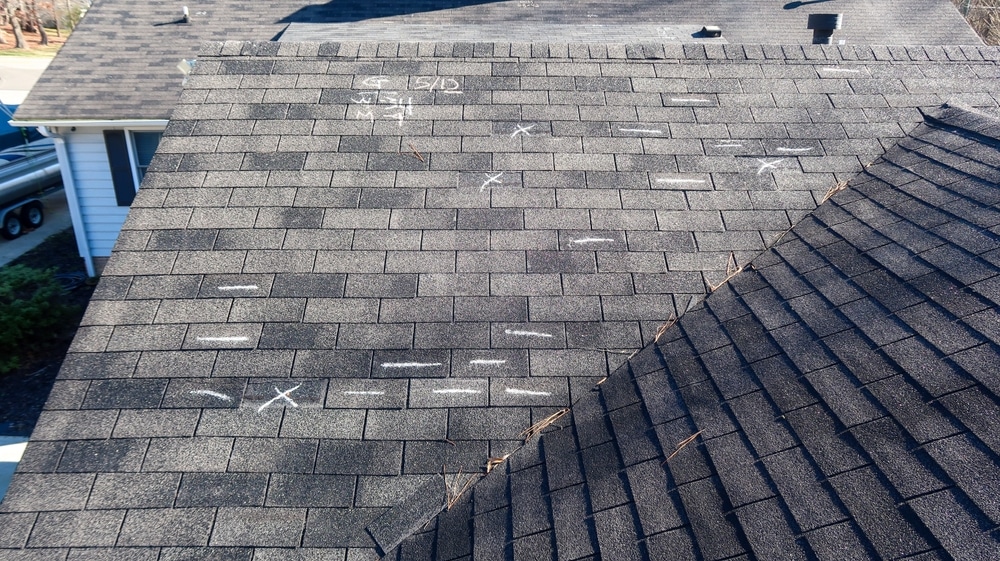Being able to identify certain possible threats to your roof’s structural integrity is naturally important for its long-term maintenance and lifespan, and hail damage is one of the most significant such threats to consider. What does hail damage look like on a roof? There are some specific signs to look out for after a hailstorm, plus some potential avenues you can take to remedy any damage that’s taken place.
At The Roof Doctor, we’re proud to offer extensive roof replacement and roof installation services around Salt Lake City, Sandy, West Jordan, West Valley City and even out to Tooele, plus roof repairs and related solutions. Here are some of the things to be thinking about during a hailstorm with regard to your roof, plus how to assess it afterward and some signs that may reveal a need for roof repair or even roof replacement if damage is significant.
What to Consider During the Storm
During an active hailstorm, you obviously can’t be outside assessing your roof’s condition. This means you’ll have to wait until the hail stops falling before you can start looking over your property for damage, including the roof. But while the storm is ongoing, there are still some important things to keep in mind that will help you better assess any potential damage once it’s safe to do so.
- The size of the hail: One of the main factors that determines how much damage hail can cause is its size. Smaller pea-sized or marble-sized hail may not cause significant damage on its own, but larger golf ball-sized or baseball-sized hail can cause serious damage to a roof and other parts of your property.
- The direction of the storm: If possible, try to take note of which direction the hail is coming from during the storm. This will help you determine which parts of your roof may have been hit the hardest and could potentially have experienced the most damage.
- The duration of the storm: A longer-lasting hailstorm means that your roof has been exposed to more potential impacts and may have sustained more damage overall.
- Your roof’s material: You can also be thinking about what your roof is made of during the storm. Certain materials, such as asphalt shingles, may be more susceptible to hail damage than others.
Assessing Damage After the Storm
Once the hail has stopped falling and it’s safe to go outside, here are some steps you can take to assess any potential damage to your roof:
- Look for visible signs: The first thing you should do is walk around your property and look for any visible signs of damage on your roof. This could include missing or cracked shingles, dented metal components, or even broken skylights.
- Check gutters and downspouts: Your gutters and downspouts can also provide clues about potential hail damage. Look for dents or dings on these elements, as well as any granules from shingles that may have been knocked off during the storm.
- Inspect your attic: If you have access to your attic, go up and check for any signs of water leaks or sunlight coming through the roof. These are both indicators that your roof has sustained damage and may need repair.
- Consider hiring a professional: If you’re not comfortable or able to safely assess your roof on your own, it’s always best to hire a professional roofer to inspect and make repairs if necessary.
Signs Your Roof May Need Repair or Replacement
After assessing your roof after a hailstorm, here are some signs that may indicate a need for repair or even replacement:
- Missing or cracked shingles: This is one of the most obvious signs of damage and should be addressed promptly to prevent further issues.
- Dented or damaged metal components: Metal flashing, gutters, and other elements can become dented or damaged during a hailstorm, compromising their effectiveness.
- Water leaks: If you notice water leaks in your attic or ceilings after a storm, it’s likely that your roof has sustained damage and needs repair.
- Excessive granules in gutters: Granules from asphalt shingles can protect against UV rays and provide insulation. If you see an excessive amount of granules in your gutters after a hailstorm, it could mean that your shingles have been damaged and may need to be replaced.
Insurance Considerations
One vital aspect to keep in mind when dealing with potential hail damage to your roof is your homeowners insurance. Make sure to document any visible damage and speak with your insurance provider about filing a claim. They may send an adjuster to assess the damage and provide coverage for repairs or replacement depending on your policy.
Hailstorms can cause significant damage to roofs, so it’s important for homeowners to be aware of what to look for during and after a storm. By considering factors like hail size, direction of the storm, duration, and roofing material, you can better assess any potential damage. It’s also crucial to hire a professional roofer if needed and keep insurance considerations in mind.
At The Roof Doctor, we understand the importance of addressing hail damage promptly and effectively. Contact us today for expert roofing services to protect your home against these types of threats and extend the lifespan of your roof, whether you’re in SLC, Sandy, West Jordan, West Valley, Tooele, Lehi, Orem, Layton, or any nearby part of Utah!



